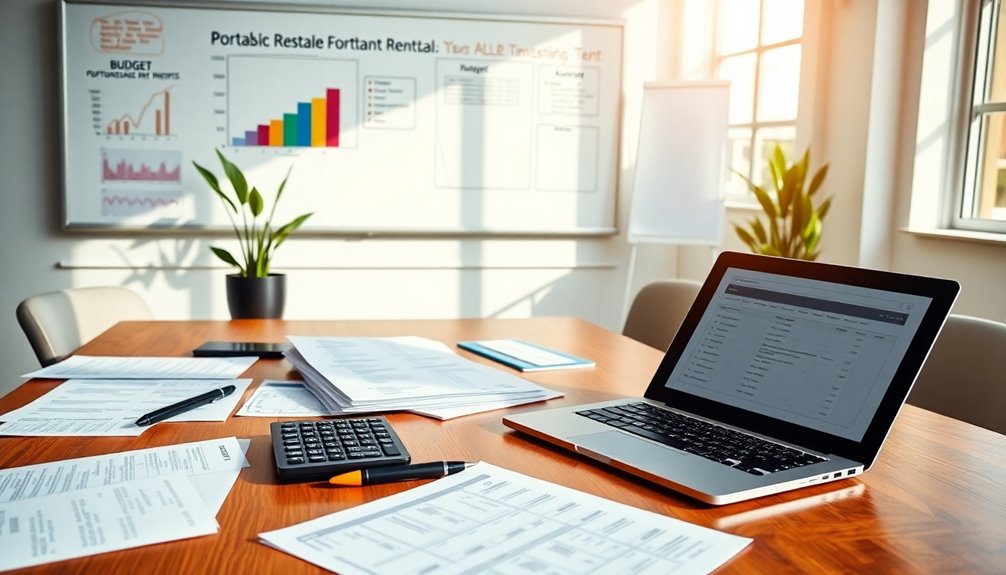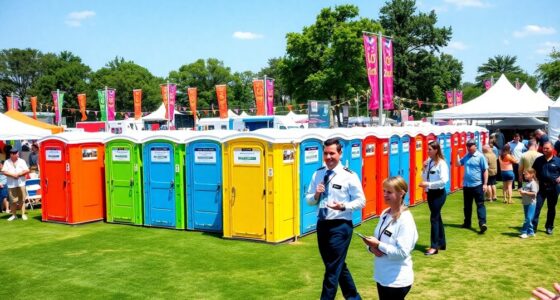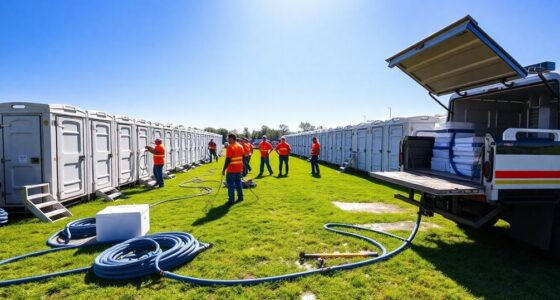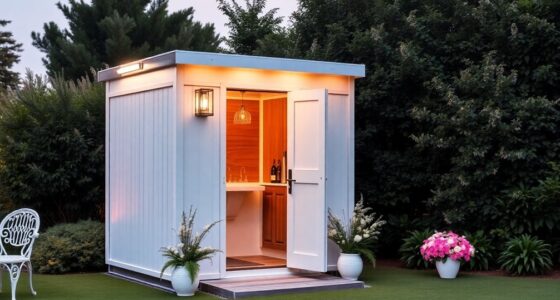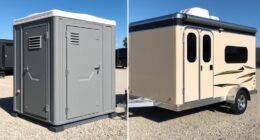When budgeting for portable restroom rentals, start by evaluating your event size or construction team's needs. For events, plan for one unit per 50 guests, and for construction, a restroom for every 10-15 workers. Remember to factor in rental costs, which can range from $75 to $150 a day, plus potential additional service fees. Proper planning and tracking can lead to a smooth experience, and there's more important information to take into account.
Key Takeaways
- Determine the number of portable restrooms needed based on event size, recommending one unit per 50 attendees for events lasting four hours.
- Factor in rental costs, typically ranging from $75 to $150 per day, and include potential service fees that could increase expenses by 20-30%.
- Assess project requirements, using past data to inform budget decisions, ensuring accurate cost allocation for restroom rentals.
- Plan for regular maintenance services, which may cost between $50 to $100 per week, based on event size and frequency of use.
- Document all expenses clearly, using project codes for tracking invoices, to maintain clarity and consistency in budgeting.
Understanding Porta Potty Requirements for Events and Construction Sites

When planning for events or construction sites, you need to understand the proper porta potty requirements to guarantee everyone's comfort and sanitation.
For construction projects, aim for one portable restroom for every 10-15 workers to maintain productivity and hygiene.
During a four-hour event, one porta potty for every 50 guests is ideal to meet restroom needs and enhance attendee satisfaction.
Consider placing these units in high-traffic areas, ensuring compliance with health regulations and accessibility standards.
If your event lasts longer than four hours or serves alcohol, plan for additional restrooms to accommodate increased demand.
Proper placement near food areas and attention to ventilation can greatly improve user experience and maintain portable sanitation standards.
Analyzing Rental Costs and Budget Implications

Budgeting for portable restroom rentals involves understanding the various costs associated with different options.
You need to evaluate several factors that influence rental costs and overall budgeting:
- Standard porta potties: $75 to $150 per day
- Recommended ratio: one restroom per 50 guests for four-hour events
- Additional service fees: can add 20-30% to total rental costs
- Monthly rentals: $75 to $100 per unit, including basic maintenance
If you opt for luxury restroom trailers, be prepared to spend $600 daily or more.
Analyzing these costs helps you align your choices with your budget constraints, ensuring you meet your needs without overspending.
Always plan for the unexpected to avoid financial pitfalls.
Effective Strategies for Cost Allocation

When it comes to effective cost allocation for portable restroom rentals, you should start by analyzing your project expenses closely.
Tracking rental invoices and categorizing your budget helps maintain clarity and consistency across your financial statements.
This approach not only simplifies reporting but also guarantees you're prepared for any additional costs that may arise.
Analyzing Project Expenses
To effectively analyze project expenses, you'll want to allocate portable restroom rental costs to specific projects using project codes. This approach guarantees accurate tracking and budgeting.
Here are some effective strategies to contemplate:
- Estimate rental needs based on the recommended ratio, like one unit per 50 guests.
- Document all associated expenses, including delivery and maintenance, which can add 20-30% to base rental costs.
- Utilize past project data to inform your budgeting decisions.
- Collaborate with an accountant to categorize restroom rental expenses under utilities or project costs.
Tracking Rental Invoices
Although tracking rental invoices may seem tedious, it's vital for effective cost allocation in your projects. Keep detailed records of all invoices, including unit types, rental duration, and associated costs. Organizing invoices by project codes streamlines expense tracking, guaranteeing proper allocation of restroom rental costs.
Here's a simple way to visualize your tracking:
| Rental Duration | Associated Costs |
|---|---|
| Weekly | $200 |
| Monthly | $600 |
| Event | $150 |
Utilize accounting software or spreadsheets to categorize expenses, making it easier to review costs and identify trends. Regularly reconcile invoices against budget forecasts to monitor spending and guarantee compliance with your financial plans. Implement a system for approving invoices to avoid discrepancies.
Allocating Budget Categories
Allocating budget categories effectively guarantees you can track expenses accurately and maintain financial integrity in your projects.
When dealing with portable restroom rentals, it's essential to categorize your costs appropriately.
Consider the following strategies:
- Classify rental expenses as Utilities or Project Costs.
- Document all rental agreements, quotes, and receipts for accountability.
- Use project codes or identifiers to track restroom expenses against specific projects.
- Regularly review and adjust your budget based on actual usage and service needs.
Factors Influencing Rental Decisions

When planning your portable restroom rentals, consider the size of your event and its location.
Larger gatherings will require more units, while urban settings might come with higher costs due to accessibility challenges.
Understanding these factors will help you make informed decisions and stick to your budget.
Event Size Consideration
Understanding the size and nature of your event is essential for determining how many portable restrooms you'll need.
Factors influencing this event size consideration include:
- For events lasting four hours, allocate one portable restroom for every 50 attendees.
- Additional units may be necessary if you're serving alcohol or the event exceeds four hours.
- The type of event, like concerts or festivals, impacts the number of units needed for guest comfort.
- Prioritize high-traffic areas for restroom placement to enhance accessibility.
- Consideration of portable restroom solutions can elevate the overall guest experience at your event.
Location and Accessibility
To guarantee a smooth experience for your attendees, strategically placing portable restrooms is vital. Focus on high-traffic areas to enhance accessibility and user satisfaction. Additionally, it’s important to ensure that these facilities comply with local health and safety standards. Understanding portable restroom regulations will help you avoid potential fines and ensure that your event remains a pleasant experience for everyone involved. By prioritizing cleanliness and accessibility, you can significantly elevate the overall enjoyment of your attendees.
If your event lasts longer than four hours, consider increasing the number of units to reduce wait times. Don't forget to position restrooms near food and beverage areas; this encourages frequent use and promotes hygiene.
Also, make sure that you include ADA-compliant units in your location plan, as compliance with regulations is essential.
Proper ventilation and clear signage are important too, guiding users efficiently to the restroom facilities. By prioritizing these factors, you'll create a more convenient and enjoyable experience for everyone involved.
Planning for Additional Services and Maintenance
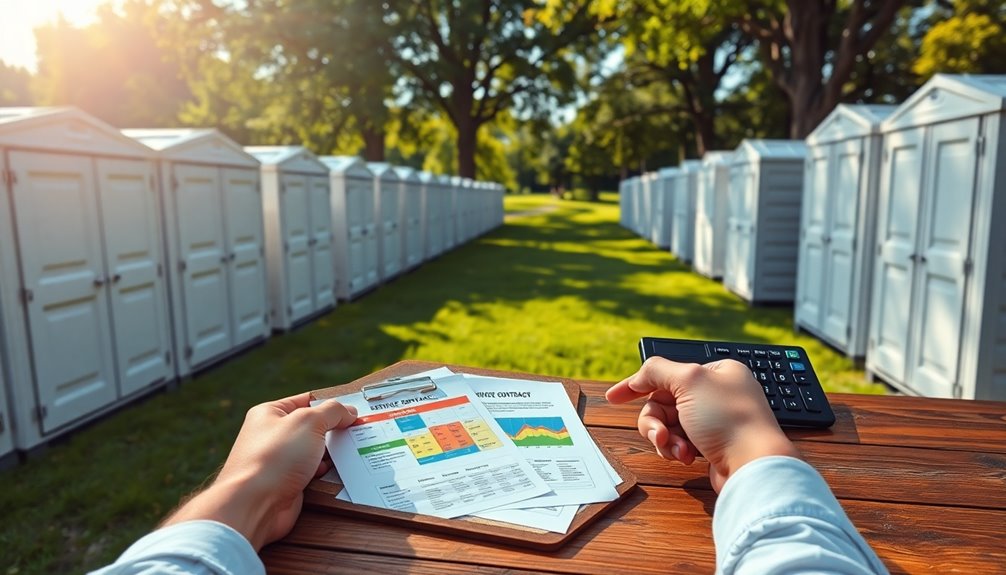
While budgeting for portable restroom rentals, it's important to account for additional services and maintenance that guarantee a pleasant experience for your guests.
Remember that these costs can add 20-30% to your total budget due to delivery fees, pickup, and cleaning. Regular maintenance services, typically $50 to $100 per week, are vital for hygiene.
Consider the following when planning your budget:
- Frequency of servicing based on event size
- Location impact on maintenance costs
- Potential emergency cleaning expenses
- Additional amenities to enhance guest comfort
Best Practices for Tracking and Reporting Expenses
Tracking expenses for portable restroom rentals can feel overwhelming, but establishing a clear system makes it manageable. Start by gathering and documenting all invoices and receipts from rental companies to guarantee accurate expense tracking.
Utilize accounting software to categorize and organize these expenses, streamlining financial reporting for your project budgets. Keep detailed records of all associated costs, including delivery, cleaning, and maintenance fees, to get a complete picture of total expenditures.
Allocate restroom rental costs to specific projects using project codes, allowing for precise tracking and assessment over time. Regularly review and adjust your expense reports to reflect any changes in rental agreements or additional services, so your budget stays accurate and up-to-date.
Frequently Asked Questions
How Profitable Is Portable Potty?
Portable potties can be quite profitable for rental companies. Depending on the type and amenities, you can charge anywhere from $75 to $2,500 per day.
Standard units generally offer higher profit margins due to lower costs, while luxury options command premium prices.
By adding services like cleaning and maintenance, you can boost your earnings by 20-30%.
With good inventory management and strategic pricing, you could even achieve six-figure annual revenues.
What Kind of Expense Is a Porta Potty Rental?
A porta potty rental is typically considered a business expense.
You can categorize it under utilities, rent, or project-specific costs, depending on your business needs.
Keeping detailed records of these expenses, like invoices and associated fees, is essential for accurate financial reporting and tax purposes.
If you're unsure how to classify these rentals, it's best to consult with an accountant to guarantee compliance with financial regulations.
Conclusion
In the end, budgeting for portable restroom rentals is like steering a ship through uncharted waters. By understanding your requirements and analyzing costs, you can sail smoothly toward success. Remember to allocate funds wisely, consider additional services, and keep track of your expenses. With these strategies in place, you'll guarantee your event or construction site remains comfortable and efficient for everyone involved. So, chart your course, and let your planning lead the way!
